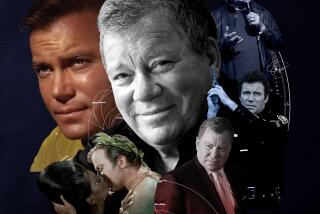An Outlaw and a Gentleman
- Share via
I recently made the acquaintance of Sherman, a very unusual horse. I’d heard his story before I met him, but was still unprepared for the 13-year-old red roan horse with the large, soft eyes. Given his past, I expected to see a few fiery snorts issuing forth from his nostrils. He’d been shuffled from owner to owner, tried at many things, including a short bout on the race track. He couldn’t be caught in his stall. One “problem horse” trainer had even wrapped barbed wire around Sherman’s bit to control him. But Sherman wouldn’t cooperate. He earned the label of outlaw. He just couldn’t seem to find his place in life.
Then one day several years ago, Sherman met up with Rick Hawthorne, a very unusual person. The meeting was arranged at the request of a friend of Hawthorne, who thought the two of them might get along. Hawthorne is into an unusual form of horsemanship called vaulting, which is the art of performing gymnastics on a moving horse. Not just any moving horse will do. It takes a well-trained, gentle, reliable sort of horse.
Consider the trust that you must place in a moving horse if you’re doing, say, a “stand” (which is just as it sounds) on his back. If the horse suddenly stops, changes gaits or skitters to one side, you might find yourself flying through the air. Or what would happen if several vaulters were mounted at once and the horse decided to buck? In short, it seemed preposterous that Sherman would be a likely candidate for this sport, and Hawthorne was justifiably dubious about his friend’s request that he give Sherman a try.
But it was finally Sherman’s turn to have something work out. When Hawthorne vaulted onto the horse’s back for the first time, Sherman continued circling calmly, as though he was quite familiar with what was expected. The next time Sherman was used for vaulting, three people leaped on his back, performing what’s known as a triple. When Hawthorne tells the story, you’d think Sherman had been a vaulting horse in a past life.
According to Hawthorne, it can take months to develop a good vaulting horse, which must circle at a consistent pace for 15 to 20 minutes at a stretch while as many as three vaulters mount and do intricate acrobatics. After a brief three weeks of training, Sherman made his competitive debut.
One example of Sherman’s exceptional aptitude for vaulting occurred at a show where he was inadvertently entered in a class where he was to circle to the right. Sherman had only worked to the left. While a casual observer might assume that a horse could simply reverse and go the other way with equal ease, that is not always the case. Horses are usually better going one way or the other--just as some people are right-handed and other people left-handed. And although it’s the vaulters, not the horse, who are judged in competition, the animal’s even pace and action can determine the score for the vaulter. Sherman’s place in the annals of vaulting history was assured when--going against his preference--he earned first-, second- and third-place awards for his individual vaulters.
But all that was years ago. Nowadays, he’s the idol of Valley View Vaulters in Tujunga, a team that Hawthorne and his partner, Virginia Manges, have organized. Vaulters range from age 4 to adult; many have physical handicaps. The day I met Sherman, one child accidentally rolled his wheelchair nearly under the horse’s belly. Sherman only nudged the contraption and stood patiently until order was restored.
So how is it that this one-time rogue came to be the darling of Valley View Vaulters? Well, if Sherman remembers that he was once called outlaw, he’s too much of a gentleman to reveal his past. One can see that by the way he lowers his head so even the smallest vaulter can pay her respect. The team clusters around the blaze-faced horse at every opportunity, clinging affectionately to his legs and tumbling beneath his feet. He likes being appreciated. He even likes the rows of braids and bows sewn into his mane for competition, arching his neck and stepping proudly when it’s his turn to perform. His hoofbeats are the heartbeat of the team. How could any horse, even a former outlaw, not respond to that kind of love?






